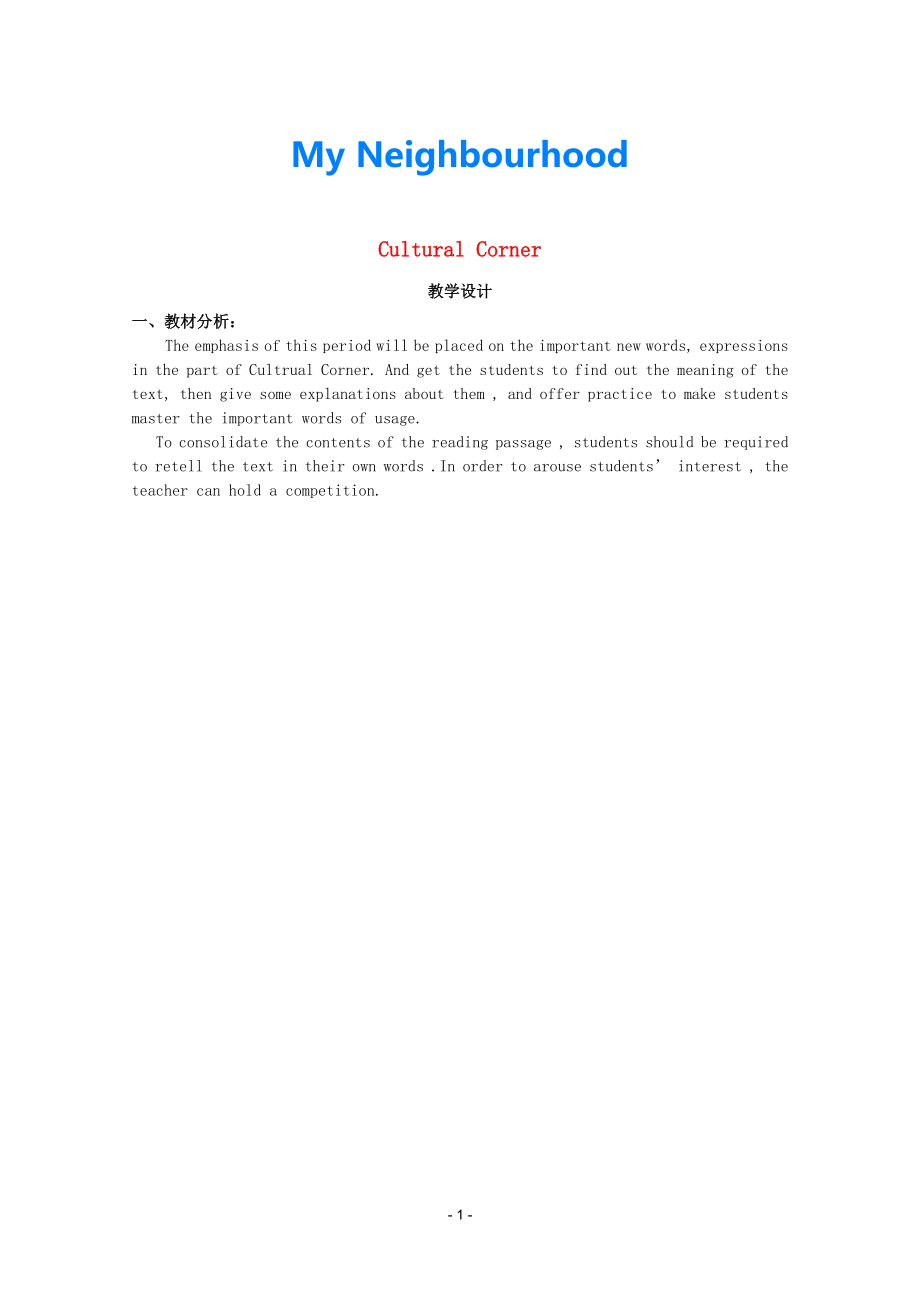《2021高中英語 Module4 A Social Survey-My Neighbourhood Corner教案 外研版必修1》由會(huì)員分享�,可在線閱讀�,更多相關(guān)《2021高中英語 Module4 A Social Survey-My Neighbourhood Corner教案 外研版必修1(4頁珍藏版)》請(qǐng)?jiān)谘b配圖網(wǎng)上搜索�。
1、優(yōu)質(zhì)文檔 優(yōu)質(zhì)人生
My Neighbourhood
Cultural Corner
教學(xué)設(shè)計(jì)
一�、教材分析:
The emphasis of this period will be placed on the important new words, expressions in the part of Cultrual Corner. And get the students to find out the meaning of the text, then give some explanations about them , and offer practice to mak
2、e students master the important words of usage.
To consolidate the contents of the reading passage , students should be required to retell the text in their own words .In order to arouse students’ interest , the teacher can hold a competition.
二�、教學(xué)目標(biāo)
1.知識(shí)目標(biāo)
Get the students to learn and grasp
3、the following important useful new words and expressions in the part:
A number of, go up, Another problem is that… , survive
2.能力目標(biāo)
1)Train Ss’integrating skills and grasp information about villages in western Europe
2)Learn more about villages in western Europe and grasp key words and phrase
4�、s
3.情感目標(biāo)
1)Raise ss’ cooperation awareness.
2)Enable ss love their own homeland.
三�、教學(xué)重難點(diǎn)
重點(diǎn)Get the students to learn and grasp the following important useful new words and expressions in the part: A number of, go up, Another problem is that… , survive
難點(diǎn) Ss’integrating skills and grasp info
5�、rmation about villages in western Europe
四、學(xué)情分析
學(xué)生對(duì)于西歐鄉(xiāng)村生活不熟悉�,指導(dǎo)學(xué)生課前查尋相關(guān)材料,利用工具書培養(yǎng)學(xué)生自學(xué)能力�。
五、教學(xué)方法
學(xué)案導(dǎo)學(xué):見學(xué)案
新授課教學(xué)基本環(huán)節(jié):預(yù)習(xí)檢查 總結(jié)疑惑; 情景導(dǎo)入 展示目標(biāo)�;合作探究 精講點(diǎn)撥;反思總結(jié) 當(dāng)堂檢測(cè)�;發(fā)導(dǎo)學(xué)案 布置預(yù)習(xí)。
六�、課前準(zhǔn)備
1 學(xué)生的課前準(zhǔn)備:預(yù)習(xí)課文,初步理解�,查閱資料,嘗試練習(xí)�。
2 教師的教學(xué)準(zhǔn)備:多媒體課件制作,課前預(yù)習(xí)學(xué)案�,課后延伸拓展學(xué)案,分好小組�。
七、課時(shí)安排 四十分鐘
八�、教學(xué)過程
Step 1 Check(預(yù)習(xí)檢查 總結(jié)疑惑)
6、
檢查落實(shí)學(xué)生的預(yù)習(xí)情況并了解學(xué)生的疑惑�,是教學(xué)有了針對(duì)性。
Step 2 Lead in
1.Look at the screen and tell me which one is the city and which is the village ?
A city is usually ( rich modern…)
A village is usually (small poor…)
2.What do you know about western Europe?
Step 3 Fast Reading
Read the passage again and
7�、 try to summarize the main idea of each paragraph.
Suggested answers:
Paragraph 1: Some villages in western Europe are disappearing.
Paragraph 2: Reasons for the change of the villages.
Paragraph 3: Hopes for the survival of the villages.
Step 4 Careful Reading
1.Read and answer:
1)Why are
8�、 some villages disappearing nowadays?
2)Why do people move to the cities to find work ?
3)Who cannot afford to buy a house there?
Suggested answers:
1)Young people move to towns for a livelier life and for work .
2)People can’t afford village house because city-dwellers buy them up.
3)Farmer
9�、s sell their land and stop farming.
Step 5 Language study
1.a number of: a lot of 大量的 ;后面接名詞復(fù)數(shù)
the number of : 是......的數(shù)量 �;后面接名詞復(fù)數(shù)
例如:A number of apples are red
許多蘋果是紅色的
The number of students is 2000
學(xué)生的數(shù)量是2000人
2.go up (價(jià)格�、水位、數(shù)量等的)上漲
eg: (1) The price of vegetables went up becau
10�、se of the heavy rain that slowed the growth of green plants.
(2)In the past 10 years, the population of the town has gone up by 5.5 percent, much smaller than that of thirty years ago.
3.Another problem is that it is becoming more and more difficult for farmers to make money from their farms.
4.
11、Survive : continue to live or exist ,especallly in a diffcult or dangerous situation
(1) Only 12 of the 140 passengers survived the plane crash.
(2) Few buildings survived the bombing raids intact.
(3) Many strange customs have survived from earlier times
Step 6 Sum up
The villages in western
12�、 Europe are... ,the number of people... ,the price ... ,the problem is that....
Step 7 Discussion
What problems does the village have in your area?
Step 8 Homework
Write a composition about your villages in your hometown.
九�、板書設(shè)計(jì)
1. A city is usually ( rich modern…)
A village is usually (smal
13�、l poor…)
2. My hometown is... ,the number of people... ,the price ... ,the problem is that....
十、教學(xué)反思
本課的設(shè)計(jì)采用了課前下發(fā)導(dǎo)學(xué)案�,學(xué)生預(yù)習(xí)本節(jié)內(nèi)容,找出自己迷惑的地方�。課堂上師生主要解決重難點(diǎn)�,疑點(diǎn)�,考點(diǎn),易混點(diǎn)�,最后進(jìn)行當(dāng)堂檢測(cè)�,課后進(jìn)行拓展延伸,以達(dá)到提高課堂效率的目的�。通過文章:介紹西歐農(nóng)村生活的變化,讓學(xué)生增加對(duì)西方國(guó)家社會(huì)生活的了解�。主要是訓(xùn)練閱讀技能,同時(shí)增加對(duì)西歐農(nóng)村的了解�,跨文化意識(shí)的培養(yǎng)也很重要�,利用作業(yè)環(huán)節(jié)讓學(xué)生對(duì)我國(guó)農(nóng)村的發(fā)展進(jìn)行思考。教學(xué)案應(yīng)精心設(shè)計(jì)才能調(diào)動(dòng)學(xué)生積極參與提高課堂效率�,加大課堂容量。在今后學(xué)習(xí)中會(huì)繼續(xù)探究本節(jié)課�,爭(zhēng)取更科學(xué)的設(shè)計(jì)�,更有利于學(xué)生學(xué)習(xí)�。
- 4 -
本資料來自網(wǎng)絡(luò)若有雷同概不負(fù)責(zé)
 2021高中英語 Module4 A Social Survey-My Neighbourhood Corner教案 外研版必修1
2021高中英語 Module4 A Social Survey-My Neighbourhood Corner教案 外研版必修1

